Let's now continue to the end of page 46:

|
E:42 |
| ku noho era a a
Ira.i apina nui.i tuu mai |
Ira had
remained in Apina Nui and was there when Makoi
returned.
Ira gave the name 'Apina Nui A Papa Nihoniho A
Vere Nuanua A Papa O Rae' to the neck of the figure
of Hinariru. |
| ai.a a makoi.ki
apina nui.he nape e Ira |
| i te ingoa.ko
apina nui a Papa nihoniho |
|
a vere nuanua a Papa o rae i
te ngao o te |
|
moai o hinariru. |
|
Vere. 1.
Beard, moustache (vede G); vere gutu,
moustache; verevere, shaggy, hairy, tow,
oakum. Mgv.: veri, bristly, shaggy, chafed
(of a cord long in use). Mq.: veevee,
tentacles. Ta.: verevere, eyelash. 2. To weed
(ka-veri-mai, pick, cut-grass T); verevere,
to weed. P Mgv.: vere, to weed. Mq.:
veéveé, vavee, id. 3. Verega,
fruitful, valuable; verega kore, unfruitful,
valueless, contemptible, vain, futile, frivolous;
tae verega, insignificant, valueless; mataku
verega kore, scruple. Mgv.: verega, a
design put into execution; one who is apte, useful,
having a knowledge how to do things. 4. Ta.:
verevere, pudenda muliebria. Ma.: werewere,
id. (labia minora). Churchill. Sa.:
apungaleveleve, apongaleveleve, a spider,
a web. To.: kaleveleve, a large spider. Fu.:
kaleveleve, a spider, a web. Niuē:
kaleveleve,
a cobweb. Nukuoro: halaneveneve,
a spider. Uvea: kaleveleve,
a spider. Mgv.: pungaverevere,
a spider. Pau.: pungaverevere,
cloth. Mg.: pungaverevere,
a cobweb. Ta.: puaverevere,
id. Mao.: pungawerewere,
puawerewere,
puwerewere,
a spider. Ha.: punawelewele,
a spider, a web. Mq.: pukaveevee,
punaveevee,
id. Vi.: lawa,
a fishing net; viritālawalawa,
a cobweb; butalawalawa,
a spider. Churchill 2.
Nua.
1. Mother; this seems a more ancient word than
matu'a poreko. 2. Blanket, clothing, cape
formerly made from fibres of the mahute tree.
Vanaga. Cloak T. Churchill.
Nu'a 1.
Thick; piled one on top of the other, as
leis,
mats, or ocean swells; heaped; lush, thick-growing;
much traveled, as a road; multitude, as of people,
mass. Also hānu'a.
Moena kumu nu'a,
a sleeping mat made thick at one end to serve as a
head rest; lit. 'mat piled beginning'.
Nu'a
moena, a
heap of mats. Nu'a
kanaka, many people.
Haki nu'a ka uahi i
ke kai, the spray breaks in masses in the
sea. Ka nu'a o ka
palai, the thick clump of
palai
ferns. Ho'o nu'a,
to heap up; to give generously and continuously; to
indulge, as a child; surging, rising in swells, as
the sea. 2. A kind of seaweed. Nu'a-kea, a
goddess of lactation. Wehewehe.
Nuahine. 1. Old woman. 2. Ko te Nuahine
ká umu a ragi kotekote, ancient name of 'the
woman in the moon' inspired by the resemblance of
its landscape with the likeness of a woman sitting,
lighting the fire of her oven. Vanaga. Nuehine.
Old woman. Churchill. "[Englert
1948, 165:] '... se selia nombrar Ko te Nuahine
káumu ŕ rangi kote kote que significa: La vieja
que enciende el curanto en el cielo kotekote.
Puedo haber sido una personificación de la luna
porque las viejos decían, comentando este nombre,
que no es una montańa que seve en la luna, sino una
mujer anciana que está suntada [sentada?] al lado un
gran curanto umu pae (de piedras en
circulo)." (Barthel) |
| ina kai hakamaa
Penei e ku naa ana te moai |
Nothing [ina
kai] at all was said, and thus [penei]
the figure and the ornament remained a secret [naa]. |
| te tuitui reipa. |
| he hoki he oho mai
arurua.he oo ki roto ki te ana |
The two
turned around, went on, entered [he oo ki roto ki]
the cave, and remained there.
Ira took [he too mai] the string (hau)
for making string-figures (kaikai) in order
to introduce [uru mo hakamaa] Makoi to the
game and help him gain knowledge of the content (urunga)
of the string-figures. |
| he noho.he too mai a
Ira.i te hau mo te kaikai |
| mo uru.mo hakamaa i
a Makoi.i te urunga o te kai(-) |
| kai. |
| Uruga.
Prophetic vision. It is said that, not long before
the first missionaries' coming a certain Rega
Varevare a Te Niu saw their arrival in a vision
and travelled all over the island to tell it:
He-oho-mai ko Rega Varevare a Te Niu mai Poike, he
mimiro i te po ka-variró te kaiga he-kî i taana
uruga, he ragi: 'E-tomo te haűti i Tarakiu, e-tomo
te poepoe hiku regorego, e-tomo te îka ariga koreva,
e-tomo te poporo haha, e-kiu te Atua i te ragi'. I
te otea o te rua raá he-tu'u-hakaou ki Poike; i te
ahi mo-kirokiro he-mate. Rega Varevare, son of
Te Niu, came from Poike, and toured
the island proclaiming his vision: 'A wooden house
will arrive at Tarakiu (near Vaihú), a
barge will arrive, animals will arrive with the
faces of eels (i.e. horses), golden thistles will
come, and the Lord will be heard in heaven'. The
next morning he arrived back in Poike, and in
the evening when it was getting dark, he died.
Vanaga.
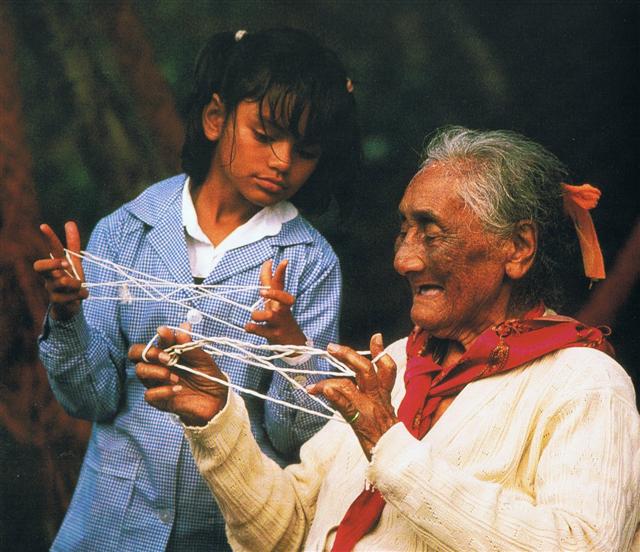 |
|
E:43 |
|
... string
games could be resumed after it was clear that the
Sun had managed to leave the horizon and was rapidly
gaining in altitude: 'Before the sun starts to leave
the horizon ... when it shows only on the horizon,
... then string games were no longer allowed as they
might lacerate the sun. Once the sun had started to
go higher and could be seen in its entirety, string
games could be resumed, if one so wished. So the
restriction on playing string games was only
applicable during the period between the sun's
return and its rising fully above the horizon ... |
| he uru a Ia.i te
kaikai.he hakaiti i te kai(-) |
Ira went
through (the forms of) the string figures and showed
them to Makoi. Ira said to Makoi, 'Now you recite (?
hoa mai) the verses (patautau) of
these string figures'.
[Two stone statues, erua moai, of Tuu
Hokorua:] (1) Ko Apina Iti
ko
Rapa Kura. |
| kai.kia Makoi.he ki
a Ira.kia Makoi ka |
| hoa mai koe i te
patautau o te kaikai nei.erua |
| moai a tuu hokorua
ko apina iti ko rapa kura. |
|
... |
|
E:46 |
|
hanga piko a hare
rutu manu a ana onoono |
Curved Bay
[hanga
piko], the house where
the bird beats (the rhythm), that is, where a
certain chant is being recited, Ana Onoono (a cave
well-suited as an overnight shelter), Pu Ngotangota
(a coastal formation where seawater is allowed to
flow in and out).
'Yours is the morning shadow' [ata popohanga toou]
refers to an area in Ata Hero where the house of
Ricardo Hero is now located. 'Yours is the evening
shadow' [ata
ahiahi toou]
belongs
to a 'turtle' [honu].
'Apina Nui A Papa Nihoniho A Vere Nuanua A Papa O
Rae' was the neck [te
ngao]
of the figure of Hinariru. |
| a pu ngotangota.ata
popohanga toou e to ata |
| hero ē.ata ahiahi
toou e honu ē.apina |
| nui a Papa
nihoni(ho) a vere nuanua a Papa o rae. |
| i te ngao o te moai
o hinariru. |
|
Vere.
1. Beard, moustache (vede
G); vere gutu, moustache; verevere,
shaggy, hairy, tow, oakum. Mgv.: veri,
bristly, shaggy, chafed (of a cord long in use).
Mq.: veevee, tentacles. Ta.: verevere,
eyelash. 2. To weed (ka-veri-mai, pick,
cut-grass T); verevere, to weed. P Mgv.:
vere, to weed. Mq.: veéveé, vavee,
id. 3. Verega, fruitful, valuable; verega
kore, unfruitful, valueless, contemptible, vain,
futile, frivolous; tae verega, insignificant,
valueless; mataku verega kore, scruple. Mgv.:
verega, a design put into execution; one who
is apte, useful, having a knowledge how to do
things. 4. Ta.: verevere, pudenda muliebria.
Ma.: werewere, id. (labia minora). Churchill.
Sa.: apungaleveleve, apongaleveleve, a
spider, a web. To.: kaleveleve, a large
spider. Fu.: kaleveleve, a spider, a web.
Niuē: kaleveleve, a cobweb. Nukuoro:
halaneveneve, a spider. Uvea: kaleveleve,
a spider. Mgv.: pungaverevere, a spider.
Pau.: pungaverevere, cloth. Mg.:
pungaverevere, a cobweb. Ta.: puaverevere,
id. Mao.: pungawerewere, puawerewere,
puwerewere, a spider. Ha.: punawelewele,
a spider, a web. Mq.: pukaveevee,
punaveevee, id. Vi.: lawa, a fishing net;
viritālawalawa, a cobweb; butalawalawa,
a spider. Churchill 2.
Nua.
1. Mother; this seems a more
ancient word than matu'a poreko. 2. Blanket,
clothing, cape formerly made from fibres of the
mahute tree. Vanaga. Cloak T. Churchill. Nu'a
1. Thick; piled one on top of the other, as leis,
mats, or ocean swells; heaped; lush, thick-growing;
much traveled, as a road; multitude, as of people,
mass. Also hānu'a. Moena kumu nu'a, a
sleeping mat made thick at one end to serve as a
head rest; lit. 'mat piled beginning'.
Nu'a moena, a heap of mats. Nu'a
kanaka, many people. Haki nu'a ka uahi i ke
kai, the spray breaks in masses in the sea.
Ka nu'a o ka palai, the thick clump of palai
ferns. Ho'o nu'a, to heap up; to give
generously and continuously; to indulge, as a child;
surging, rising in swells, as the sea. 2. A kind of
seaweed. Nu'a-kea, a goddess of lactation.
Wehewehe.
Nuahine.
1. Old woman. 2. Ko te Nuahine ká umu a ragi
kotekote, ancient name of 'the woman in the
moon' inspired by the resemblance of its landscape
with the likeness of a woman sitting, lighting the
fire of her oven. Vanaga. Nuehine. Old woman.
Churchill. "[Englert 1948, 165:] '... se selia
nombrar Ko te Nuahine káumu ŕ rangi kote kote
que significa: La vieja que enciende el curanto en
el cielo kotekote. Puedo haber sido una
personificación de la luna porque las viejos decían,
comentando este nombre, que no es una montańa que
seve en la luna, sino una mujer anciana que está
suntada [sentada?] al lado un gran curanto umu
pae (de piedras en circulo)." (Barthel) |
| he oti te Pautautau
nei |
Here the verses ended [he
oti]. |
|
Oti.
To come to an end; to suffice, to be enough:
ku-oti-á, it is finished; ina kai oti mo kai,
there is not enough to eat; he-oti á,
there isn't anymore left, it's the last one; it's
enough with that. Vanaga. Ta.: 1. Oti,
presage of death. Sa.: oti, to die. 2. To
cut. Mq.: koti, oti, id. Sa.: 'oti,
id. Ma.: koti, id. Churchill.
... hakatautau, to append.
P Pau.: fakatautau, to hang up. Mq.:
tautau, id. Ta.: faatautau, id. ...
kau-kau, to take counsel, to resolve, to chide,
to reprove, to explain, make clear ... tau-tau,
to hang, hang up ...
Pau.
1. To run out (food, water):
ekó pau te kai, te vai, is said when there is an
abundance of food or water, and there is no fear of
running out. Puna pau, a small natural well
near the quarry where the 'hats' (pukao) were
made; it was so called because only a little water
could be drawn from it every day and it ran dry very
soon. 2. Va'e pau, clubfoot. Paupau:
Curved. Vanaga. 1. Hakapau, to pierce (cf.
takapau, to thrust into). Pau.: pau, a
cut, a wound, bruised, black and blue. 2. Resin.
Mq.: epau, resin. Ta.: tepau, gum,
pitch, resin. (Paupau) Hakapaupau, grimace,
ironry, to grin. 3. Paura (powder),
gunpowder. 4. Pau.: paupau, breathless. Ta.:
paupau, id. 5. Ta.: pau, consumed,
expended. Sa.: pau, to come to an end. Ma.:
pau, finished. 6. Ta.: pau, to wet one
another. Mq.: pau, to moisten. Churchill.
Paua or pāua is the Māori name
given to three species of large edible sea snails,
marine gastropod molluscs which belong to the family
Haliotidae (genus Haliotis), known in
the USA as abalone, and in the UK as ormer shells
... Wikipedia |
| i te raa Po rae o
hora nui i iri ai ki runga |
... On the
first day of the month of September ('Hora Nui')
they went up to the yam plantation of Kuukuu |
|
ki te uhi a kuukuu. |
| i oho era mai Pu
Pakakina he tuu ki vai |
After they
had departed from Pu Pakakina they reached Vai
Marama and met [he piri] a man. Ira asked [he
ui a Ira], 'How many are you?' [hokohia koe].
He answered, 'There were two of us' [hokorua
Maua]. Ira continued asking, 'Where is [hē]
he
(the other)?' To that he answered, 'The one died.' [ku
mate ana]
Again Ira asked, 'Who has died?' [koai i mate]
He replied, 'That was Te Ohiro A Te Runu.'
Ira asked anew [he ui hokoou], 'And who
are you?' [koai koe] He answered [he ki
mai], 'Nga Tavake A Te Rona'. |
| marama he piri etahi
tangata.he ui a Ira. |
| hokohia koe.he ki
mai hokorua Maua |
| he ui hokoou atu a
Ira.hē ia.he ki hoko(-) |
| ou mai ku mate
ana.he ui hokoou |
| a Ira.koai i mate.he
ki mai.ko te ohiro |
|
a te runu.he ui
hokoou a Ira.koai koe he |
| ki mai.ko
nga
tavake.a te rona. |
|
Ga. Preposed plural marker of rare usage. 1.
Sometimes used with a few nouns denoting human
beings, more often omitted. Te ga vî'e, te ga
poki, the women and the children. Ga rauhiva
twins. 2. Used with some proper names. Ga Vaka,
Alpha and Beta Centauri (lit. Canoes). Vanaga.
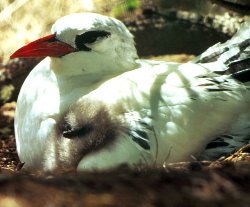
Rona. Figure made of wood, or stone, or painted,
representing a bird, a birdman, a lizard, etc.
Vanaga. Drawing, traction. Pau.: ronarona, to
pull one another about. Churchill. While the
rongorongo signs (rona) are generally 'carved
out, incised' (motu), ta implies an
incision ('cutting, beating') as well as the process
of applying signs to the surface with the aid of a
dye ... RAP. rona means primarily 'sign' (an
individual sign in the Rongorongo script or a
painted or carved sign made on a firm background,
such as a petroglyph), but also 'sculpture' (made
from wood or stone, representing animals of hybrid
creatures) ... rona (lona) implies the
idea of 'maintaining a straight line' with ropes and
nets and also the maintaining of a steady course (in
MAO. and TUA.). Te Rona is the name of a star
in TUA., which Makemson (1941:251) derives from the
mythical figure of 'Rona', who is connected
with the moon and is considered to be the father of
(the moon goddess) Hina (for this role in
MAO., see Tregear 1891:423). From west Polynesia
come totally different meanings. Interesting perhaps
is FIJ. lona, 'to wonder what one is to eat,
fasting for the dead.' ... Barthel 2 |
The Explorers had gone to Pu Pakakina in "August 29 and
they had stayed there for a month:
... On the twenty-ninth day of the month of
August ('Hora Iti') they went on to Pu Pakakina. They arrived,
remained there, and gave the name 'Pu Pakakina A Ira'.
They remained one month in Pu Pakakina. (E:31)
Yet, they had left already in "September 1:
... On the first day of the month of September ('Hora Nui') they
went up to the yam plantation of Kuukuu - i te raa Po rae o
hora nui i iri ai ki runga ki the uhi a kuukuu (E:46).
| te hokohuki |
te moko |
vero
hia |
tagata honui |
e
ha mata |
|
Ha. 1. Four. 2. To breathe.
Hakaha'a, to
flay, to skin. Vanaga. 1. Four. P Mgv., Mq., Ta.: ha, id.
2. To yawn, to gape. 3. To heat. 4. Hakaha,
to skin, to flay; unahi hakaha, to scale
fish. Mgv.: akaha, to take to pieces, to take
off the bark or skin, to strip the leaves off
sugarcane. 5. Mgv: ha, sacred, prohibited.
Mq.: a, a sacred spot. Sa.: sa, id.
Churchill. |
 |
 |
 |
 |
 |
|
Cb8-4 |
Cb8-5
(172 + 4) |
Cb8-6
(177 = 6 * 29˝) |
Cb8-7
(392 + 178 = 570) |
Cb8-8
(1˝ * 314 + 100) |
|
CLOSE TO THE FULL
MOON: |
|
γ Hydrae (201.0), ι Centauri (201.4)
*160.0 = *201.4 - *41.4 |
Al Simāk-12 (Lofty) /
Chitra-14 (Bright One) /
Horn-1 (Crocodile) /
Sa-Sha-Shirū-20
(Virgin's Girdle) /
ANA-ROTO-3 (Middle pillar)
MIZAR = ζ Ursae Majoris
(202.4),
SPICA
= α Virginis,
ALCOR
= 80 Ursae Majoris
(202.7)
SADALMELIK (α Aquarii)
*161.0 = *202.4 - *41.4 |
71 VIRGINIS
(203.6) |
no star
listed (204) |
HEZE
= ζ Virginis
(205.0),
Southern Pinwheel Galaxy = M83 Hydrae
(205.7) |
|
... Proclus
informs us that the fox star nibbles continuously at
the thong of the yoke which holds together heaven
and earth; German folklore adds that when the fox
succeeds, the world will come to its end. This fox
star is no other than Alcor, the small star g
near zeta Ursae Majoris (in India Arundati,
the common wife of the Seven Rishis, alpha-eta Ursae
...
 |
|
Oct 8
(240 + 41) |
9 |
10 |
11 (364 - 80) |
12 (285) |
|
'Sept 11 (354 - 100) |
12 |
13 (256
= 4 * 64) |
14 |
15 |
|
"Aug 28
(240) |
HORA ITI 29 |
30 (242
= 2 * 11 * 11) |
31 |
HORA NUI 1 |
|
AHU
AKAPU |
PU
PAKAKINA A IRA |
|
Paka. 1. Dry; to become dry (of things);
pakapaka, to dry out. Te paka is also
the name of the moss-covered areas, between the
small lakes of volcano Rano Kau, through
which one can pass without getting one's feet wet.
2. To go, to depart; he-paka-mai, to come;
he-oho, he-paka, they go away. 3. To become calm
(of the sea): ku-paka-á te tai. Pakahera,
skull, shell, cranium; pakahera puoko tagata,
human skull; pakahera pikea, shell of crab or
crayfish. Gutu pakapaka, scabbed lips. Hau
paka, fibres of the hauhau tree, which
were first soaked in water, then dried to produce a
strong thread. Moa gao verapaka, chicken with
bald neck. Ariki Paka, certain collateral
descendents of Hotu Matu'a, who exercised
religious functions. Vanaga. 1. Crust, scab, scurf;
paka rerere, cancer; pakapaka, crust,
scabby. 2. Calm, still. 3. Intensive; vera paka,
scorching hot; marego paka, bald; nunu
paka, thin. 4. To arrive, to come. 5. To be
eager. 6. To absorb. 7. Shin T. Pakahera,
calabash, shell, jug. Pakahia, to clot,
curdle, coagulate. Pakapaka, dry, arid,
scorching hot, cooked too much, a desert, to fade
away, to roast, a cake, active; toto pakapaka,
coagulated blood; hakapakapaka, to dry, to
broil, to toast. Pakahera pikea, shell of
crab or crayfish. Churchill.
Kinana,
s. Haw., a hen that has hatched chickens.
Sam., tina, a
mother. Tong.,
tina-manu, a sow that had litter.
Tah., ti'a, the
lower part of the stomach, below the navel.
Fiji., tina,
mother; tina-tina, mother of inferior
animals. N.
Zeal., tinana, the buttocks, trunk, body.
This word, with
somewhat varying but not far separate meanings, I am
inclined to consider as related to the
Goth., kwens,
kwino, a woman; kwina-kunds and
kwineins, female; and possibly kwithus,
the womb, the stomach, if that is syncope of an
original kwinthus. Greek,
γυνη, woman ... |
|
CLOSE TO THE
SUN: |
|
April 8
no
star listed (18) |
9
ADHIL
(Garment's Train) = ξ Andromedae
(19.3),
θ
Ceti (19.7) |
10 (100)
KSORA (Knee) = δ Cassiopeiae
(20.1),
ω
Andromedae (20.6),
γ
Phoenicis (20.8) |
11 (364 - 263)
δ
Phoenicis (21.5) |
12
υ Andromedae (22.9) |
|
'March
12 |
13 |
14 (73) |
15 |
16 |
|
"Febr 26 |
27 |
28 (59) |
29 |
"March 1 |
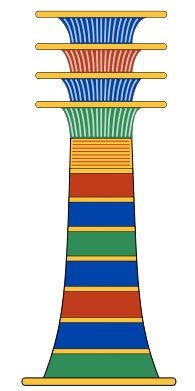 |
This mystery can possibly be related to the one
who died, viz. Te Ohiro A Te Runu. The dark night of the
moon was Ohiro.
Whiro
'Steals-off-and-hides'; also [in addition to the name of
Mercury] the universal name for the 'dark of the Moon' or
the first day of the lunar month; also the deity of sneak
thieves and rascals.
Makemson.
Runu. To take, to
grab with the hand; to receive, to welcome someone in one's
home. Ko Timoteo Pakarati ku-runu-rivariva-á ki a au i
toona hare, Timoteo Pakarati received me well in his
house. Runurunu, iterative of runu: to take
continuously, to collect. Vanaga. 1. To pluck, to pick, a
burden. 2. A substitute; runurunu, a representative.
Churchill.
Mercury was only visible for a short while at the equinoxes
(and then he 'died').
... Ganz ähnlich is der Name 'Gott von Duazag' des Gottes
Nabū ... zu erklären. Er bezeichnet
ihn als den Gott des Wachtstums, welches als aus dem Osten
stammend betrachtet wird, weil die Sonne, die das Wachstum
bringt, im Osten aufgeht. Dass aber Nabū als
Ost-Gott aufgefasst wurde, hängt damit zusammen, dass sein
Stern, der Mercur, nur im Osten oder Westen sichtbar ist ...

The earliest remembered time-frame for the Sun at the
northern spring equinox was when this place had been occupied by
Gemini - Nga Vaka:
... In far antiquity (5800 B.C.) the spring equinoctial point
was predicted by the heliacal rising of the Twins (see fig. 6.6)
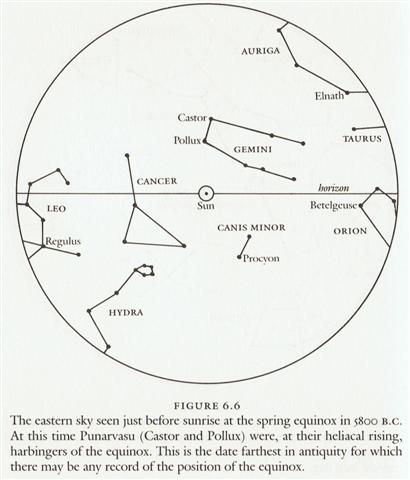
Thus Nga Tavake A te Rona (Sign) could have referred
to Pollux (Polydeuces), whereas the existence of the mortal Castor
(Beaver) could have been only inferred.
... In Hindu legend there was a mother
goddess called Aditi, who had seven offspring. She is
called 'Mother of the Gods'. Aditi, whose name means
'free, unbounded, infinity' was assigned in the ancient lists of
constellations as the regent of the asterism Punarvasu.
Punarvasu is dual in form and means 'The Doublegood
Pair'. The singular form of this noun is used to refer to the
star Pollux. It is not difficult to surmise that the other
member of the Doublegood Pair was Castor ...
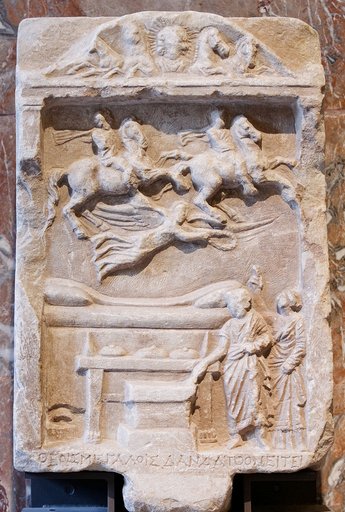
... In the Gospel of Mark III.17, the 'twins'
James and John, the sons of Zebedee, are given by Jesus the name
of Boanerges, which the Evangelist explains as meaning 'Sons of
Thunder'. This was long overlooked but eventually became the
title of a work by a distinguished
scholar, too soon forgotten, Rendel Harris. Here the Thunder
Twins were shown to exist in cultures as different as Greece,
Scandinavia and Peru. They call to mind the roles of Magni and
Modi, not actually called twins, but successors of Thor, in
Ragnarok. But to quote from Harris:
We have shown that it does not necessarily
follow that when the parenthood of the Thunder is recognized, it
necessarily extends to both of the twins. The Dioscuri may be
called unitedly, Sons of Zeus; but a closer investigation shows
conclusively that there was a tendency in the early Greek cults
to regard one twin as of divine parentage, and the other of
human. Thus Castor is credited to Tyndareus, Pollux to Zeus
...
The extra child made the trouble, and was
credited to an outside source. Only later will the difficulty of
discrimination lead to the recognition of both as Sky-boys or
Thunder-boys. An instance from a remote civilization will show
that this is the right view to take. For example, Arriaga, in
his 'Extirpation of Idolatry in Peru' tells us that 'when two
children are produced at one birth, which they call Chuchos or
Curi, and in el Cuzco Taqui Hua-hua, they hold it for an impious
and abominable occurrence, and they say, that one of them is
the child of the Lightning, and require a severe penance, as
if they had committed a great sin'.
And it is interesting to note that when the
Peruvians, of whom Arriaga speaks, became Christians, they
replaced the name of Son of Thunder, given to one of the twins,
by the name of Santiago, having learnt from their Spanish
(missionary) teachers that St. James (Santiago) and St. John had
been called Sons of Thunder by our Lord, a phrase which these
Peruvian Indians seem to have understood, where the great
commentators of the Christian Church had missed the meaning
...
Another curious and somewhat similar transfer
of the language of the Marcan story in the folk-lore of a
people, distant both in time and place ... will be found, even
at the present day, amongst the Danes ... Besides the
conventional flint axes and celts, which commonly pass as
thunder-missiles all over the world, the Danes regard the fossil
sea-urchin as a thunderstone, and give it a peculiar name. Such
stones are named in Salling, sebedaei-stones, s'bedaei;
in North Salling they are called sepadeie-stones. In
Norbaek, in the district of Viborg, the peasantry called them
Zebedee stones! At Jebjerg, in the parish of Cerum, district
of Randers, they called them sebedei-stones ...
The name that is given to these thunderstones
is, therefore, very well established, and it seems certain that
it is derived from the reference to the Sons of Zebedee in the
Gospel as sons of Thunder. The Danish peasant, like the
Peruvian savage, recognised at once what was meant by Boanerges,
and called his thunderstone after its patron saint. This might
have given pause to later hyperscholars like Bultmann, before
they proceeded to 'de-mythologize' the Bible. One never
knows what one treads underfoot ...

... In Greek and Roman mythology, Castor
... Κάστωρ,
Kastōr, 'beaver', and Pollux or Polydeuces
... Πολυδεύκης, Poludeukēs,
'much sweet wine', were twin brothers, together known as the
Dioscuri Διόσκουροι,
Dioskouroi, 'sons of Zeus'. Their mother was Leda, but
Castor was the mortal son of Tyndareus, king of Sparta, and
Pollux the divine son of Zeus, who visited Leda in the guise of
a swan. Though accounts of their birth are varied, they are
sometimes said to have been born from an egg, along with their
twin sisters Helen of Troy and Clytemnestra.
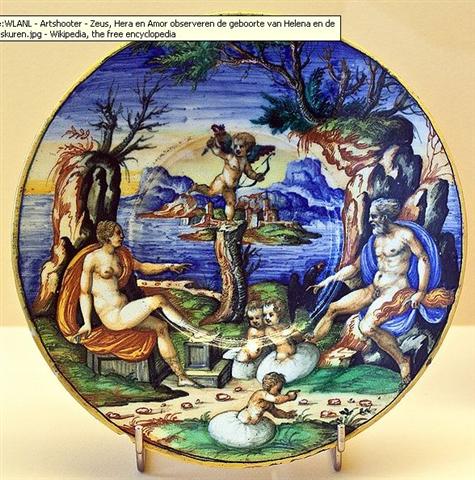
Perhaps the page number (46) reminded the
creators of Manuscript E of how much the precession had shifted
the star roof ahead in the year since ancient times.
... Allen has documented all his star
culminations at 21h, which should be due to an effort of keeping
the culminations at their proper places according to the
ancients, 24h (spring equinox) - 21h = 3h = 24h / 8 = 45ş. 3h
corresponds to 366 / 8 = 45.75 of my right ascension days and
*366 - *46 = *320 (Dramasa, σ
Octantis) ...
In Roman times the Day of St John had been
defined as day number 175 (= 350 / 2 = 25 * 7).
... The son of Zebedee and Salome, James is
styled 'the Greater' to distinguish him from the Apostle James
'the Less', who was probably shorter of stature. We know nothing
of St. James's early life. He was the brother of John, the
beloved disciple, and probably the elder of the two ... James'
emblem was the scallop shell (or 'cockle shell'), and pilgrims
to his shrine often wore that symbol on their hats or clothes.
The French for a scallop is coquille St. Jacques, which
means 'cockle (or mollusk) of St. James'. The German word for a
scallop is Jakobsmuschel, which means 'mussel (or clam)
of St. James'; the Dutch word is Jacobsschelp, meaning
'shell of St. James' ... The scallop shell is represented in the
decoration of churches named after St. James, such as in St
James' Church, Sydney, where it appears in a number of places,
including in the mosaics on the floor of the chancel. When
referring to St James, the scallop shell is represented with
convex perspective. Referring to Venus the perspective is
concave ... The date to celebrate St James (the Great) was July
25 in Western Christianity, April 30 in Eastern Christianity,
and December 30 in the Hispanic Church. On the other hand, St
John (the apostle) was celebrated in December 27 according to
all these church traditions. St George, who died in April 23 in
the year 303 AD, was celebrated in April 23 ...
Whereas at the time of rongorongo the convex shell representing St James
was at July 25 (*122 - *64 ↔
Ata Popohanga):
|
MAY
14 |
15
(365 + 135 = 500) |
16
(136) |
17 |
18 (*58 = 2 * 29) |
19 |
 |
 |
 |
 |
 |
 |
|
Ga2-24 |
Ga2-25 |
Ga2-26 |
Ga2-27→ π |
Ga2-28 (141 - 83) |
Ga2-29 (59) |
|
φ Gemini (118.4)
*77.0 = *118.4 - *41.4 |
DRUS
(Hard) = χ Carinae
(119.9) |
ω
Cancri (120.2) |
8h (121.7)
χ Gemini (121.0),
NAOS
= ζ Puppis
(121.3) |
ρ
Puppis (122.0),
HEAP OF FUEL
= μ Cancri
(122.1),
ζ
Monocerotis (122.3), ψ
Cancri (122.6),
REGOR (Roger backwards) = γ Velorum
(122.7) |
TEGMINE = ζ Cancri
(123.3) |
|
July
17 |
18 |
19
(200) |
20
(*121) |
21 |
22 /
7 |
|
°July 13 |
14 |
15
(196) |
16 |
17
(*118 = 4 * 29˝) |
18 |
|
'June 20 |
SOLSTICE |
22
(173) |
23 |
ST JOHN'S DAY |
25 (*96) |
|
"June 6 |
7 |
8 |
9
(*80) |
Te Maro 10
(161) |
11 |
|
he ea.a Ira.he iri he oho ki runga anake.
i te angahuru o te raa o
te maro i iri ai - Ira got
up. They all climbed to the top of the hill.
They climbed up on the
tenth day of the month of June ('Maro’).
(E:18) |
|
DAY
118 - 64 = 54
54
Vai Rapa
a
haka remereme |
31 + 24 = 55 |
56 (Sic!) Te
Vai Rutu Manu
a
koro rupa e haho e hivi e e runga e te puku ohu
kahi e |
57 Hanga Piko
(Curved Bay)
a
hare utu manu a ana onoono a pu ngotangota |
58 Ata
Popohanga (Morning Shadow)
toou
e to ata hero ē |
59 Ata Ahiahi
(Evening Shadow)
toou
e honu ē |
|
... The leap day was introduced as part of the
Julian reform. The day following the Terminalia
(February 23) was doubled, forming the 'bis
sextum - literally 'double sixth', since
February 24 was 'the sixth day before the
Kalends of March' using Roman inclusive counting
(March 1 was the 'first day').
Although exceptions exist,
the first day of the bis sextum (February
24) was usually regarded as the intercalated or
'bissextile' day since the third century.
February 29 came to be regarded as the leap day
when the Roman system of numbering days was
replaced by sequential numbering in the late
Middle Ages
... |
E:46 |
|
1 Ko Apina Iti |
27 |
29 Ko Te Rano A Raraku |
(30) |
|
29 |
|
30 |
|
31 Oparingi |
11 |
(43) |
1 |
45 Vai ngaere |
8 |
54 Vai Rapa |
(55) |
4 |
60 Apina Nui |
|
12 |
11 |
5 |
|
24 |
|
|
... The
'watering place' where the bird beats (the
rhythm)' - wordplay, 'where a certain chant is
being recited' - is located near Hanga Piko. A
recitation provides the following information
for the additional name:
'In Koro Rupa is the house where one is made to
laugh; in Kere Mea is the house where one is
made fun of' (Barthel 1960:851; Campbell
1971:400). There the rule of the new birdman was
celebrated (compare koro 'feast'). In
RAP., koro rupa seems to have the same
meaning as in TUA. kororupo, which
describes a paradise. In the cosmology of the
TUA., the name also referred to the entrance to
the underworld. Hivi (maybe the same as
hi ivi 'to fish with a hook made from
bone'; compare the narrative ME:363) is
'outside', and 'the elevation from where (the
catch of) the tunafish is announced' is 'above'.
This is a reference to a large boulder beside
the place where the canoes docked in Hanga Piko.
There the people waited for the canoes to return
from the fishing grounds.
'Curved Bay',
the well-known little harbour on the western
shore, is linked with a 'house where the bird
beats (the rhythm), that is, where a certain
chant is being recited. This establishes a
cross-connection to the watering place by the
same name and also to the 'Koro Rupa' motif and
the theme of the birdman cult. It also suggests
the newly discovered petroglyphs from Hanga Piko
(so far, only partially published by Barthel
1962:Illustration 2). Ana Onoono is a cave
well-suited as an overnight shelter; Pu
Ngotangota is a coastal formation where seawater
is allowed to flow in and out. The three
additions, 'house', 'cave', and 'hole', always
describe an enclosed area.
'Yours is the morning shadow' refers to an area
in Ata Hero where the house of Ricardo Hero is
now located. 'Yours is the evening shadow'
belongs to a 'turtle'. I could not obtain any
information about the location, but I suspect
that the 'turtle' refers to a motif in the
narration of Tuki Hakahevari (the turtle is
carved in stone in a cave along the bay of
Apina) ... (The
Eighth Land, pp. 89-90.) |
|
Kere. To moor, to make
fast. Kerekere, black, dark, blue,
obscure, gloom; niho kerekere, blackened
teeth. Hakakerekere, to blacken. P Pau.:
kerekere, black, dark, somber. Mgv.:
kerekere, blue, dark blue almost black, the
color of the deep ocean, black, somber,
darkness. Mq.: kerekere, keékeé,
black, somber, livid; ere, blue, azure.
Ta.: ereere, black. Churchill.
ELEą,
v. Haw., be dark, black; adj.
dark-coloured, black, blue, dark-red, brown;
ele-ele, id. Tah., ere-ere, dark,
black, blue. Rarot., kerekere, id.
Marqu., kekee, id.; kee-voo,
darkness, gloom. The application of this word to
colour is doubtless derivative from the Polynes.
Haw. kele, mud, mire (quod vide),
Tong. kčle-kere, earth, soil, dirt, Sam.
'ele and 'ele-ele, red earth, dirt,
rust; elea, Tong., kelea, rusty,
dirty; probably all akin to ala, ara,
in ala-ea, earth, clay ... Jav., iran,
black. N. Celebes (Kema), hirun, id. In
the following Greek words the first constituent
proclaims their affinity to the Polynesian
ere, ele: -
ερεβος,
darkness of the grave, the dark passage from
earth to Hades; ερεβεννος, dark, gloomy;
ερεμνος, sync. fr. previous word, black,
swarthy; ερεφω, to cover; ορφνη,
darkness of night; ορφνος, dark, dusty;
οροφη, roof of a house. Sanskr.,
aruņa,
tawny, dark, red; s.
the dawn, the sun; aruņita,
made red. Benfey refers the Sanskrit word to
arus,
a wound. Lidell and Scott refer the Greek words
to ερεφω,
to cover. They are plausible; but are they the
true roots of stems, in view of the Polynesian
ele,
ere?
Dr. J. Pickering, in his Greek Lexicon, derives
ερεβος
'from ερα
(the earth) or ερεφω
(to cover)'. The former seems to me the better
reference.
ELE˛,
prefix.
Haw., an intensitive added to many words,
imparting a meaning of 'very much, greatly';
ele-u,
alert, quick; ele-ma-kule,
old, aged, helpless; ele-mio,
tapering to a point; ele-ku,
easily broken, very brittle; ele-hei,
too short. Tah., ere-huru,
encumbered, too much of a thing. A. Pictet ...
says, apropos of the derivation of the word
Erin:
'L'irlandais er
comme adjectif magnus, nobilis, paraît ętre
identique ŕ l'er
intensitif de l'irlandais et du cymrique,
considéré comme une particule inséparable, et
qui serait ainsi proprement un adjectif. Il est
ŕ remarquer en confirmationm, que le zend
airya =
sanskr. arya
avec l'acception de bon, juste, est également
devny ér
dans les composés du Pârsi, comme
ér-maneshu, bon
esprit, er-tan,
bon corps (Spiegel, Avesta, i. 6). De lŕ ŕ un
sens intensitif, transition était facile.' Why
not widen the philological horizon by admittning
the Polynesian ere,
ele,
to consideration as well as the Irish, Welsh, or
Parsi? And why may not the O. Norse ar,
early, first; aerir,
messengers; the Sax. er,
before, in time, go up to the same root as those
others? (Fornander) |
From 'June 25 (176) to July 25 (206) there were 30 days ('a
month'), and 206 - (30 - 27) = 203 (July 22 → 7 / 22 → π).
55 + 3 =
58 → Ata Popohanga → St John. Hamal (*30) -
*27 (Sheratan) = *3 right ascension days.
| tagata mau matagi |
ihe toga maa |
ura hia |
tagata maú
kihikihi erua |
|
Ura.
Ura, lobster. Űra, flame, blaze (űra
ahi), to become furious (with manava as
subject: ku-űra-á te manava). Úraúra,
bright red. Vanaga. 1. Crayfish, lobster, prawn. P
Mgv.: ura, crayfish. Mq.: uá, lobster.
Ta.: oura, crayfish, lobster. 2. Fire,
burning, to be in flames; uraga, combustion,
flame, torch; hakaura, to cause to glow, to
kindle, to light. P Mgv., Ta.: ura, a flame,
to burn. Mq: uá, id. Uraga, burden,
load, weight. Uraura, vermilion, scarlet. P
Pau.: kurakura, red. Mgv.: uraura, an
inflamed countenance. Mq.: uáuá, red, ruddy.
Ta.: uraura, red. Churchill. |
 |
 |
 |
 |
|
Cb5-4 |
Cb5-5 |
Cb5-6
(100 = 87 + 13) |
Cb5-7 |
|
CLOSE TO THE FULL
MOON: |
|
July 23
(204) |
24 |
25 (193 + 13 = 175 + 31) |
26 |
|
GREDI
(Goat) =
α
Capricorni
(307.2),
σ
Capricorni (307.5),
ALSHAT
(The Sheep) = ν Capricorni
(307.9) |
Al Sa’d al Dhabih-20 (Lucky One of the Slaughterers)
/
Ox / Herd Boy-9
(Buffalo)
DABIH
=
β
Capricorni
(308.0),
κ
Sagittarii (308.1),
SADIR
(Hen's Breast) = γ Cygni
(308.4),
PEACOCK = α Pavonis
(308.7) |
MINTAKA (δ Orionis)
ARNEB (α
Leporis) |
ALNILAM (ε Orionis)
HEKA (λ
Orionis) |
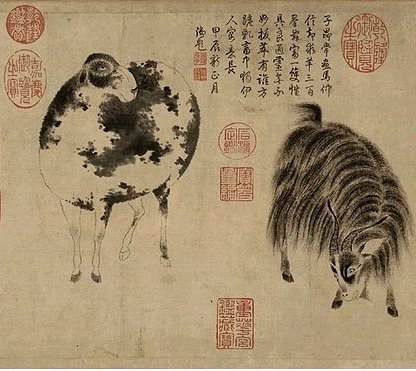 |
|
CLOSE TO
THE SUN: |
 |
 |
 |
 |
|
Ga3-1
(60) |
Ga3-2
(61) |
Ga3-3 |
Ga3-4 |
|
July 23
(204) |
24 |
25 (193 + 13 = 175 + 31) |
26 |

|



















